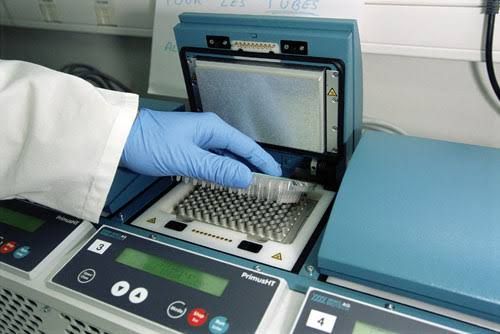
The polymerase chain reaction (PCR) is a widely used technique to amplify specific DNA fragments. The process involves several key steps that are repeated in cycles to exponentially increase the amount of target DNA. Below is a detailed step-by-step explanation of the procedures involved in PCR amplification.
1. Preparation of Reaction Components
Before starting the PCR process, it is essential to prepare all necessary components:
- Template DNA: This is the DNA fragment you wish to amplify.
- Primers: Two short sequences of nucleotides (usually 18-25 bases long) that are complementary to the regions flanking the target DNA sequence. One primer binds to each strand of the DNA template.
- Thermostable DNA Polymerase: An enzyme that synthesizes new DNA strands by adding nucleotides to the primers. Taq polymerase, derived from Thermus aquaticus, is commonly used due to its ability to withstand high temperatures.
- Deoxynucleotide Triphosphates (dNTPs): The building blocks for new DNA strands, consisting of adenine (A), cytosine (C), guanine (G), and thymine (T).
- Buffer Solution: A reaction buffer that maintains optimal pH and ionic conditions for the activity of the DNA polymerase.
- Magnesium Ions (Mg2+): A cofactor required for the activity of most DNA polymerases.
2. Setting Up the PCR Reaction
Once all components are prepared, they need to be combined in a sterile microcentrifuge tube:
- Combine Components:
- Add template DNA, primers, dNTPs, buffer solution, magnesium ions, and Taq polymerase into a microcentrifuge tube.
- Ensure that all components are mixed gently but thoroughly without introducing bubbles.
- Total Volume:
- The final volume typically ranges from 20 µL to 50 µL depending on experimental requirements.
- Optional Mineral Oil Layer:
- If using a thermal cycler without a heated lid, overlaying with mineral oil can prevent evaporation during cycling.
3. Thermal Cycling
The PCR process consists of repeated cycles involving three main temperature-dependent steps:
Step i: Denaturation
- Temperature: Typically set at around 94°C to 98°C.
- Duration: Usually lasts from 15 seconds to 2 minutes.
- Process: The double-stranded template DNA is heated to separate it into two single strands by breaking hydrogen bonds between complementary bases.
Step ii: Annealing
- Temperature: Reduced to approximately 40°C to 60°C, depending on the melting temperature (Tm) of the primers.
- Duration: Lasts about 15 seconds to 60 seconds.
- Process: Primers bind or anneal specifically to their complementary sequences on each single-stranded template.
Step iii: Extension
- Temperature: Typically set at around 70°C to 74°C for Taq polymerase.
- Duration: Generally lasts from 1 minute per kilobase (kb) of target sequence being amplified.
- Process: The Taq polymerase synthesizes new strands by adding dNTPs complementary to the template strand starting from the primer’s 3’ end.
4. Repeating Cycles
The above three steps are repeated for typically 25–35 cycles:
- Each cycle theoretically doubles the amount of target DNA present in the reaction mixture.
5. Final Extension
After completing all cycles:
- A final extension step may be performed at around 72°C for an additional few minutes (typically up to 10 minutes). This ensures that any remaining single-stranded products are fully extended.
6. Cooling Down
After amplification:
- The reaction mixture is cooled down typically at around 4°C until it can be analyzed or stored.
7. Analysis of PCR Products
Once amplification is complete:
- Gel Electrophoresis:
- The amplified products can be analyzed using agarose gel electrophoresis, which separates them based on size.
- Staining agents like ethidium bromide or SYBR Green can be used for visualization under UV light.
- Confirmation and Quantification:
- Bands corresponding to expected sizes indicate successful amplification; further analysis may include sequencing or cloning if needed.
By following these detailed steps, researchers can effectively amplify specific segments of DNA using PCR techniques tailored for various applications in molecular biology, diagnostics, and research.







